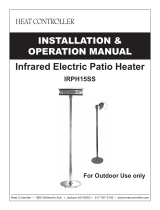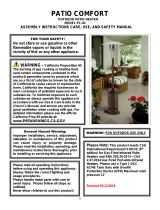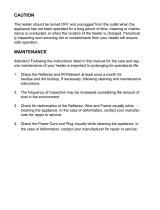
MODEL A270
INFRARED PATIO HEATERS
CSA 5.90 U.S.
SPECIFICATIONS:
! Completely Self-contained
! Rain Protected
! Wind Resistant
! No Electrical Required
! 100% Safety Shutoff Control
! 40,000 BTUH Input Rating
! Constant Pilot
! Propane Gas
P/N: 65001-11/06 Copyright 2006 By Infrared Dynamics, Inc. Printed in USA
The Original Outdoor Patio Heater
sun glo
R
Tel: (714) 572-4050 Fax: (714) 572-6093
Toll-Free: (888) 317-5255
INFRARED DYNAMICS
, INC.
Manufactured by
Yorba Linda, CA 92886 U.S.A.
www.infradyne.com
PROP. 65 WARNING!!! If not installed, operated and maintained in accordance with
manufacturer’s instructions, this product could expose you to substances in the fuel or from
combustion, including Carbon Monoxide, which can cause death or serious illness, and which are
known to the State of California to cause cancer, birth defects or reproductive harm.
WARNING: Improper installation, adjustment, alteration,
service or maintenance can cause property damage,
injury or death. Read the installation, operating and
maintenance instructions thoroughly before installing or
servicing this equipment.
If you smell gas:
1. Shut off gas to the appliance.
2. Extinguish any open flame.
3. If the odor continues, keep away from the
appliance and immediately call your gas
supplier or fire department.
DANGER
Do not store or use gasoline or other
flammable vapors and liquids in the
vicinity of this or any other appliance.
An LP cylinder not connected for use
shall not be stored in the vicinity of this
or any other appliance.
WARNING
TO THE INSTALLER: Leave this manual with the owner after
installation.
TO THE OWNER: Keep this manual in a safe place in order to
provide your serviceman with the necessary information for
future reference.
WARNING: FOR OUTDOOR USE ONLY!

Installation, Operation and Maintenance Instructions for the
Sunglo Model A270 Gas-fired Patio Heater
INSTALLATION
Important Safety Rules:
1. Children and adults should be alert to high
surface temperature of areas above the
post when operating this heater.
2. Children should be carefully supervised
when they are in the area of the heater.
3. NEVER hang anything including clothes
or other flammable items on the heater.
4. DO NOT operate this heater unless it is
fully assembled with reflector in place.
5. Installation and repair should be done by
a qualified service person. The heater
should be inspected before use and at
least annually by a qualified service
person. More frequent cleaning may be
required as necessary. It is imperative that
control compartment, burners and
circulating air passages of the heater be
kept clean.
Prior to assembling your Model A270 propane
heater, the following must be reviewed.
Compliance with the following should yield
satisfactory heater operation. These instructions
should be retained for future reference. The
installation must conform with local codes or
local authority having jurisdictions.
1. The Model A270 gas-fired infrared patio
heater is intended for heating residential and
non residential outdoor spaces. The
installation must conform with local codes or,
in the absence of local codes, with the
National Fuel Gas Code, ANSI Z223.1.
In Canada, heater installation must conform
with local building codes or, in the absence of
local codes, with the current National
Standards of Canada CAN/CGA-B 149.2.
2. Adequate clearance around air openings
into the combustion chamber, clearances
from combustible materials, provisions for
accessibility and for combustion and
ventilating air supply must be maintained
at all times when the heater is operating.
3. Proper clearance from combustible materials
must be maintained at all times. The
minimum clearances are as follows:
Minimum Clearance from Combustibles
Side 24” (61 cm)
Rear 24” (61 cm)
Ceiling 18” (46 cm)
Below 84” (84 cm)
Combustible materials are considered to be
wood, compressed paper, plant fibers, plastic,
Plexiglas or other materials capable of being
ignited and burned. Such materials shall be
considered combustible even though flame-
proofed, fire-retardant treated or plastered.
Additional clearance may be required for
glass, painted surfaces and other materials
which may be damaged by radiant or
convection heat.
4. Heaters must be placed on a level and
adequate footing and be readily accessible.
The heater may be be permanently attached
to the floor utilizing the Floor Clamp Kit (Part
No. 27020) available from the manufacturer.
5. The gas manifold supply pressure must be
regulated at 11” water column utilizing a U/L
listed regulator. Any replacement regulator
must be U/L listed. The minimum inlet
pressure to the regulator from the tank is 5
PSI and maximum pressure is 150 PSI.
6. The heater must be inspected before each
use, and at least annually by a qualified
service person.
a. The appliance area must be kept clear and
free of combustible materials, gasoline and
other flammable vapors and liquids.
b. Gas jets and burner must be kept clear of
dirt and cobwebs. Flow of combustion and
ventilation air through the perforated
portions of the heater must not be
obstructed.
c. All gas connections should be checked for
leaks utilizing a soap solution. Never use a
flame for this purpose.
d. The flame pattern at the emitter grid should
be visually checked whenever heater is
operated (see figure 1.). If flames extend
more than ½ inch beyond surface of the
emitter grid or black soot is accumulating
on the emitter grid or reflector, the heater
should be turned off immediately. The
heater should not be operated again until
repairs are made.
e. Any cleaning agent used on the heater
should be of a non-combustible and non-
corrosive nature.
f. The stainless steel emitter grid normally
does not require cleaning and should
NEVER be painted. The reflector may be
cleaned, but never painted. Other portions
of the heater may be re-coated only with
¡
high temperature (1,200 F) paint.
7. The hose assembly shall be properly located
out of pathways where people may trip over it.

The hose must be protected from contact
with hot or sharp surfaces both during use
and while in storage. The hose assembly
shall be visually inspected prior to each used
of the heater. If excessive abrasion or wear
is evident, or the hose is cut, it must be
replaced prior to operating the heater. The
replacement hose regulator, Part #90017-4,
may be obtained from manufacturer or sales
representative. See parts list.
8. DO NOT use any pressure regulator or hose
assembly other than those supplied with the
appliance. Replacement pressure regulator
and hose assembly must be those specified
by Infrared Dynamics. Replacement parts
may be obtained from the manufacturer or
your local sales representative.
9. Installation and use of this heater must
conform with local codes or, in the absence
of local codes, with the Standards for
Storage and Handling of Liquefied Petroleum
Gases, ANSI/NFPA 58.
10. Heater is designed to operate with a
standard five (5) gallon propane tank with a
TYPE1 connector only. The propane cylinder
must (1) be provided with a shutoff valve
terminating in an LP-gas supply cylinder
valve outlet specified as applicable for a
Connection No. 600 in the Compressed Gas
Associations Limited Standard Cylinder
Valve Outlet Connection for Propane-Small
Valve Series or a combination LP-gas
cylinder valve and quick-disconnect
assembly complying with 1.16.5-c and a
safety relief device having a direct
communication with the vapor space of the
cylinder; (2) the cylinder supply system must
be arranged for vapor withdrawal; and (3)
the cylinder used must include a collar to
protect the cylinder valve. The LP-gas
supply cylinder must be constructed and
marked in accordance with the specifications
Figure 1. Normal Flame Position
Figure 2. TYPE 1 Connector
for LP-gas cylinders of the U.S. Department
of Transportation.
11. Tank connector fittings must be maintained
in good condition. A leak test should be
performed with soapy water whenever a new
tank connection is made. NEVER use a
match to test for leaks.
12. Propane tank must be turned off whenever
the heater is not in use. When the heater is
to be stored indoors, the connection
between the propane cylinder and the heater
must be disconnected and stored in
accordance with Chapter 5 of the Standard
for Storage and Handling of Liquefied
Gases, ANSI/NFPA 58.
13. The A270 Sunglo Heater has been designed
with several safety features. These include
100% safety shutoff control, elevated
heating element, weighted base, and tank
quick connect coupling. Any modification to
the heater not described in the installation
instructions may compromise the safety of
this appliance. Of special concern is the
following:
(1) DO NOT shorten post length;
(2) DO NOT bypass thermocouple safety;
(3) DO NOT operate heater without a
reflector; and (4) DO NOT remove filler from
weighted base. Clothing or other flammable
materials should not be hung from the
heater, or placed on or near the heater. The
area above the post may be extremely hot.
Direct contact with these metal surfaces
should be avoided in order to prevent burns
or clothing ignition.
2”
0”
1”
TYPE 1
Connector

The Original
Outdoor Patio Heater
sun glo
R
MODEL A270
INFRARED PATIO HEATERS
CSA 5.90 U.S.
For Outdoor Operation Only


sun glo
R
Manufactured by
Yorba Linda, CA 92886 U.S.A.
Tel: (714) 572-4050 Fax: (714) 572-6093
Toll-Free: (888) 317-5255
, INC.
INFRARED DYNAMICS
www.infradyne.com
Item Part No. Description
1 70017 Nut, ¼ -20 Hex SS
2 70024 Washer, ¼ SAE SS
3 10261 Reflector, PH
4 70006 bolt, ¼ x ¾ Hex SS
5 70033 Washer, ¼ Inter SS
6 27006 Assy, PH Emitter Grid
7 70025-2 Clip, Stainless Steel
8 30225 Shield, PH Head
9 30202 Pan, PH Head
10 70005 Screw, #8 x ½ SP SS
11 30204-1 Cylinder, PH Perf (7000)
12 27007 Assy, PH Burner Pltd
13 70030 Clamp, 1"
14 35001-31 Orifice, #31 DS (Nat)
35001-49 Orifice, #49 DS (Propane)
15 35012 Adapter, Orifice
16 90002-3 Control, 7000 MRLC Nat
90003-3 Control, 7000 ERLC Nat-24V
90004-3 Control, 7000 MLC-Propane
17 80005 Nipple, ½ x 2 Blk
20 27018-1 Assy, PH H Base
27018-2 Assy, 24V PH Head Base
21 90031 Thermocouple T46518
22 80031 Tubing, AL-¼ x 14L
23 90021 Pilot, Natural #27919
90022 Pilot, Propane 327920
24 90015 Natural Pilot Orifice
90016 Propane Pilot Orifice
25 30258 PH Pilot Shield
26 27025 Assy, 7000 Handle
27 30213 Channel, PH Pilot
28 70020 Screw, #10 x 1¼ SS
29 30299 Cover, PH Pilot Hole
30 80026 Tubing Fastener-¼"
88
1
88
3

The Original
Outdoor Patio Heater
sun glo
R
Manufactured by
Yorba Linda, CA 92886 U.S.A.
Tel: (714) 572-4050 Fax: (714) 572-6093
Toll-Free: (888) 317-5255
, INC.
INFRARED DYNAMICS
www.infradyne.com

The Original
Outdoor Patio Heater
sun glo
R
Manufactured by
Yorba Linda, CA 92886 U.S.A.
Tel: (714) 572-4050 Fax: (714) 572-6093
Toll-Free: (888) 317-5255
, INC.
INFRARED DYNAMICS
www.infradyne.com

Propane Safety
Propane Gas is a heavier than air fuel that requires
that basic safety precautions. Take the time to read
the safety precautions in this manual and on the
propane tank. Consult your propane supplier in
regards to safety handling and transport of your
propane tank.
The A270 heater comes equipped with a hose and
regulator for connection to a standard 20lb propane
cylinder. All fittings necessary to attach the
hose/regulator to the heater are included. The
propane tank is not included. Operating pressure is
11.0” W.C.
Propane Tank Requirements
A dented or rusty propane tank may be hazardous
and should be checked by your propane gas supplier.
Never use a cylinder with a damaged valve. Always
check for leaks after every propane tank change.
The propane gas cylinder must be constructed and
marked in accordance with the specifications for
propane gas cylinders of the U.S. Department of
Transportation (DOT) and designed for use with a
Type 1 system only. DO NOT change the
regulator/hose assembly from that supplied with the
unit or attempt to use other types of tank connections.
Propane Tank Connections
Connect the Regulator to the tank (with the tank valve
fully closed). Although the flow of gas is stopped when
the Type 1 system is disconnected, you should
always turn the propane tank main valve off after each
use and during transport of the tank or heater. Insert
the regulator inlet into the tank valve and turn the
black coupler clockwise until the coupler is tight. Do
not over-tighten the coupler.
1. Only qualified persons are
permitted to fill propane cylinder.
2. Never attempt to repair a propane
cylinder.
3. DO NOT allow children to play or
tamper with propane cylinders.
4. When transporting, keep cylinder
secured in an upright position with
the cylinder valve turned off.
5. Store cylinders outdoors in a well
ventilated and secure area.
WARNING
To disconnect the coupler, first, make sure the main
tank valve is turned off. Grasp the coupler and turn
counter clockwise and the inlet will then disengage.
Test for Leaks
Leak tests must be performed with soapy water each
time the tank is re-connected to the heater. Once the
propane tank is connected open the tank valve. Apply
soapy water with a spray bottle or small paint brush
around tank valve and hose connections If bubbles
appear repair of the heater or tank is required before
the heater is operated.
Cylinders must be stored outdoors in a well-ventilated
area out of the reach of children. If the appliance is
stored indoors, the propane cylinder must be removed
from the appliance and stored outdoors. DO NOT
store a spare propane cylinder under or near this
appliance. NEVER fill the cylinder beyond 80 percent
full. For appliances designed to use a CGA No. 791
Connection. “Place the dust cap on the cylinder valve
outlet whenever the cylinder is not in use. Only install
the type of dust cap on the cylinder valve that is
provided with the cylinder valve. Other types of caps
or plugs may result in leakage of propane.
x
x
x
x
x
POINT OF
CONNECTION
CYLINDER
PRESSURE
RELIEF
VALV E
CYLINDER VALVE HAND WHEEL
LIQUID LEVEL
DO NOT check for gas leaks with a match or open
flame. Apply soapy water at areas marked “X”. Open
cylinder valve. If bubbles appear, close valve and have
an LP-Gas service person make needed repairs. Also
check appliance valves and connections to make sure
they DO NOT leak before lighting appliance.

, INC.
INFRARED DYNAMICS
Manufactured by
Yorba Linda, CA 92886 U.S.A.
Tel: (714) 572-4050 Fax: (714) 572-6093
Toll-Free: (888) 317-5255
www.infradyne.com
-
 1
1
-
 2
2
-
 3
3
-
 4
4
-
 5
5
-
 6
6
-
 7
7
-
 8
8
-
 9
9
-
 10
10
Ask a question and I''ll find the answer in the document
Finding information in a document is now easier with AI
Related papers
Other documents
-
 Heat Controller Patio Heater IRPH15SS User manual
Heat Controller Patio Heater IRPH15SS User manual
-
Gasmate CH206B Owner's manual
-
Desa Tech 44-PH Owner's manual
-
Hanover HAN802CGCRM User manual
-
Hanover HAN804CTTCRM User manual
-
 Patio Comfort PC02AB Owner's manual
Patio Comfort PC02AB Owner's manual
-
Luxor 2400 User manual
-
 Dr Infrared Heater DR-238 User manual
Dr Infrared Heater DR-238 User manual
-
Aura AURAPP15120SS User manual
-
FMI LPA6000 Operating instructions
















